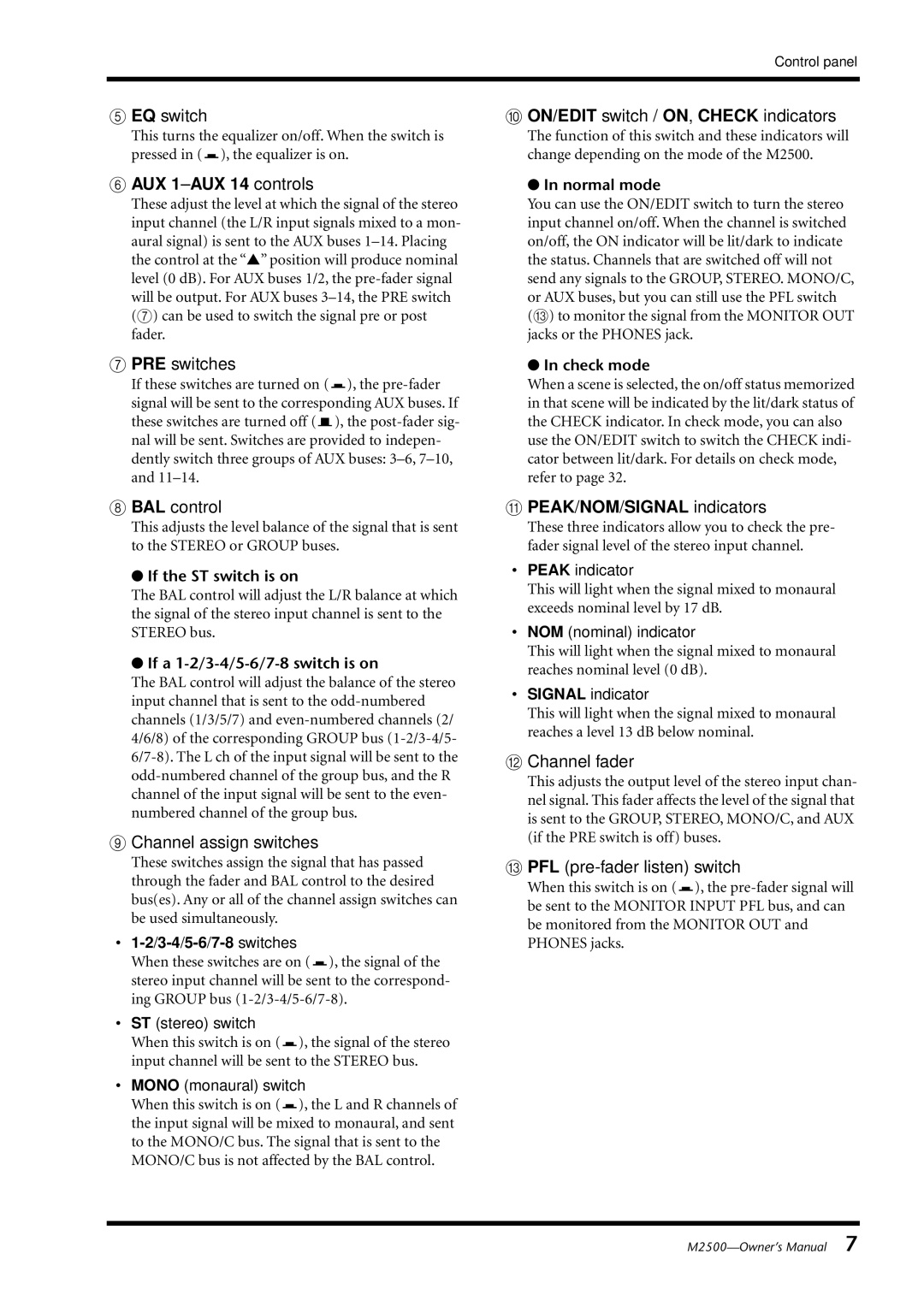
Control panel
E EQ switch
This turns the equalizer on/off. When the switch is pressed in (![]() ), the equalizer is on.
), the equalizer is on.
FAUX 1–AUX 14 controls
These adjust the level at which the signal of the stereo input channel (the L/R input signals mixed to a mon- aural signal) is sent to the AUX buses
GPRE switches
If these switches are turned on (![]() ), the
), the ![]() ), the
), the
HBAL control
This adjusts the level balance of the signal that is sent to the STEREO or GROUP buses.
●If the ST switch is on
The BAL control will adjust the L/R balance at which the signal of the stereo input channel is sent to the STEREO bus.
●If a 1-2/3-4/5-6/7-8 switch is on
The BAL control will adjust the balance of the stereo input channel that is sent to the
I Channel assign switches
These switches assign the signal that has passed through the fader and BAL control to the desired bus(es). Any or all of the channel assign switches can be used simultaneously.
•1-2/3-4/5-6/7-8 switches
When these switches are on (![]() ), the signal of the stereo input channel will be sent to the correspond- ing GROUP bus
), the signal of the stereo input channel will be sent to the correspond- ing GROUP bus
•ST (stereo) switch
When this switch is on (![]() ), the signal of the stereo input channel will be sent to the STEREO bus.
), the signal of the stereo input channel will be sent to the STEREO bus.
•MONO (monaural) switch
When this switch is on (![]() ), the L and R channels of the input signal will be mixed to monaural, and sent to the MONO/C bus. The signal that is sent to the MONO/C bus is not affected by the BAL control.
), the L and R channels of the input signal will be mixed to monaural, and sent to the MONO/C bus. The signal that is sent to the MONO/C bus is not affected by the BAL control.
J ON/EDIT switch / ON, CHECK indicators
The function of this switch and these indicators will change depending on the mode of the M2500.
●In normal mode
You can use the ON/EDIT switch to turn the stereo input channel on/off. When the channel is switched on/off, the ON indicator will be lit/dark to indicate the status. Channels that are switched off will not send any signals to the GROUP, STEREO. MONO/C, or AUX buses, but you can still use the PFL switch (M) to monitor the signal from the MONITOR OUT jacks or the PHONES jack.
●In check mode
When a scene is selected, the on/off status memorized in that scene will be indicated by the lit/dark status of the CHECK indicator. In check mode, you can also use the ON/EDIT switch to switch the CHECK indi- cator between lit/dark. For details on check mode, refer to page 32.
KPEAK/NOM/SIGNAL indicators
These three indicators allow you to check the pre- fader signal level of the stereo input channel.
•PEAK indicator
This will light when the signal mixed to monaural exceeds nominal level by 17 dB.
•NOM (nominal) indicator
This will light when the signal mixed to monaural reaches nominal level (0 dB).
•SIGNAL indicator
This will light when the signal mixed to monaural reaches a level 13 dB below nominal.
L Channel fader
This adjusts the output level of the stereo input chan- nel signal. This fader affects the level of the signal that is sent to the GROUP, STEREO, MONO/C, and AUX (if the PRE switch is off) buses.
M PFL (pre-fader listen) switch
When this switch is on (![]() ), the
), the
